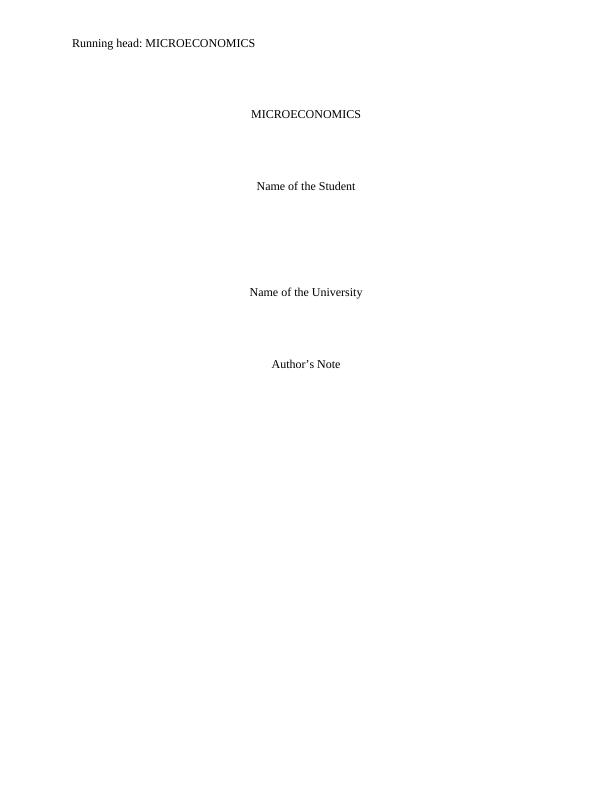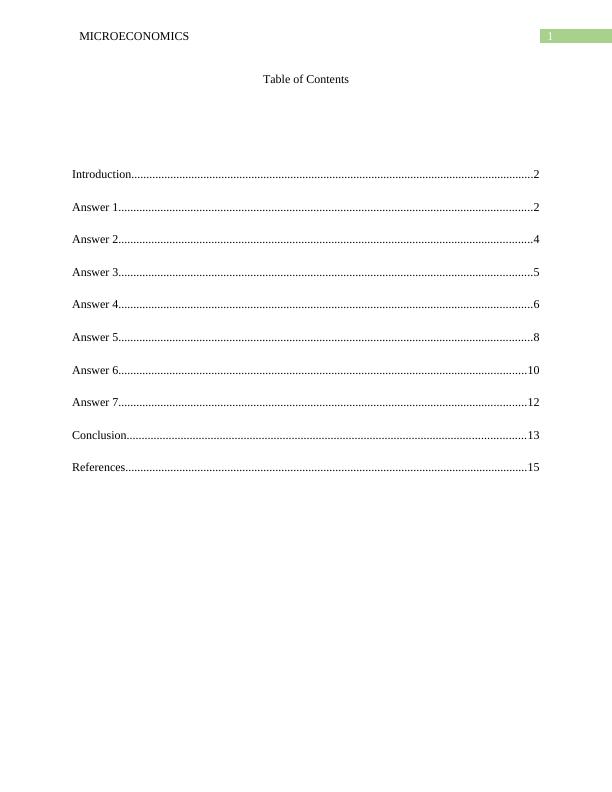Microeconomics Study: Market Equilibrium, Deadweight Loss, and Demand-Supply Shifts
Added on 2023-06-10
16 Pages2636 Words136 Views
Running head: MICROECONOMICS
MICROECONOMICS
Name of the Student
Name of the University
Author’s Note
MICROECONOMICS
Name of the Student
Name of the University
Author’s Note

1MICROECONOMICS
Table of Contents
Introduction......................................................................................................................................2
Answer 1..........................................................................................................................................2
Answer 2..........................................................................................................................................4
Answer 3..........................................................................................................................................5
Answer 4..........................................................................................................................................6
Answer 5..........................................................................................................................................8
Answer 6........................................................................................................................................10
Answer 7........................................................................................................................................12
Conclusion.....................................................................................................................................13
References......................................................................................................................................15
Table of Contents
Introduction......................................................................................................................................2
Answer 1..........................................................................................................................................2
Answer 2..........................................................................................................................................4
Answer 3..........................................................................................................................................5
Answer 4..........................................................................................................................................6
Answer 5..........................................................................................................................................8
Answer 6........................................................................................................................................10
Answer 7........................................................................................................................................12
Conclusion.....................................................................................................................................13
References......................................................................................................................................15

2MICROECONOMICS
Introduction
The purpose of this assignment is to provide an overview on the economic principles
such as market equilibrium, conditions affecting market equilibrium, consumer surplus, producer
surplus, deadweight loss, efficient allocation of resources. 1This study mainly focuses on how
demand and supply determine market equilibrium price and quantity. It elucidates on the factors
that causes shift in demand and supply of goods. Increase or decrease in demand and supply
creates change in price and quantity of commodities. This assignment also highlights on the
market demand and marginal benefit. The market demand curve is attained by the horizontal
summation of individual demand curves.
Answer 1
Which of the following would cause the equilibrium price of bread to decrease and the
equilibrium quantity of bread to increase?
a) An increase in price of butter, a complement for bread.
b) A decrease in the price of flour
c) An increase in the price of cake, a substitute for bread
d) An increase in the price of flour
(b) is the correct answer. A decrease in price of flour would cause the equilibrium price of bread
to decrease and the equilibrium quantity of bread to increase. This is shown in the diagram given
below-
1 J Gans, S King & G Mankiw, Principles of microeconomics, in , Australia, Cengage Learning, 2012.
Introduction
The purpose of this assignment is to provide an overview on the economic principles
such as market equilibrium, conditions affecting market equilibrium, consumer surplus, producer
surplus, deadweight loss, efficient allocation of resources. 1This study mainly focuses on how
demand and supply determine market equilibrium price and quantity. It elucidates on the factors
that causes shift in demand and supply of goods. Increase or decrease in demand and supply
creates change in price and quantity of commodities. This assignment also highlights on the
market demand and marginal benefit. The market demand curve is attained by the horizontal
summation of individual demand curves.
Answer 1
Which of the following would cause the equilibrium price of bread to decrease and the
equilibrium quantity of bread to increase?
a) An increase in price of butter, a complement for bread.
b) A decrease in the price of flour
c) An increase in the price of cake, a substitute for bread
d) An increase in the price of flour
(b) is the correct answer. A decrease in price of flour would cause the equilibrium price of bread
to decrease and the equilibrium quantity of bread to increase. This is shown in the diagram given
below-
1 J Gans, S King & G Mankiw, Principles of microeconomics, in , Australia, Cengage Learning, 2012.

3MICROECONOMICS
D
D
S
S
S1
S1
P
Q
P1
Q1
Price of bread
Quantity of bread
E
E1
Figure 1: Decrease in price of bread and increase in quantity of bread
Source: (As created by author)
The above figure reflects that the equilibrium occurs at the point E where the demand
curve (DD) and supply curve (SS) of bread intersects each other. Corresponding to this point, the
equilibrium price is P and the equilibrium quantity is Q. As the price of flour decreases, the
supply of bread increases. This in turn shifts the supply curve to the right from SS to S1S1. 2The
new equilibrium point occurs at E1 where the demand curve (DD) intersects the new supply
curve (S1S1). The corresponding equilibrium price is P1 and equilibrium quantity is Q1. This
reflects that the price of bread decreases from P to P1 and quantity of bread increases from Q to
Q1.
2 N Mankiw, Principles of microeconomics, in , Mason, Ohio, South-Western Cengage Learning, 2012.
D
D
S
S
S1
S1
P
Q
P1
Q1
Price of bread
Quantity of bread
E
E1
Figure 1: Decrease in price of bread and increase in quantity of bread
Source: (As created by author)
The above figure reflects that the equilibrium occurs at the point E where the demand
curve (DD) and supply curve (SS) of bread intersects each other. Corresponding to this point, the
equilibrium price is P and the equilibrium quantity is Q. As the price of flour decreases, the
supply of bread increases. This in turn shifts the supply curve to the right from SS to S1S1. 2The
new equilibrium point occurs at E1 where the demand curve (DD) intersects the new supply
curve (S1S1). The corresponding equilibrium price is P1 and equilibrium quantity is Q1. This
reflects that the price of bread decreases from P to P1 and quantity of bread increases from Q to
Q1.
2 N Mankiw, Principles of microeconomics, in , Mason, Ohio, South-Western Cengage Learning, 2012.

End of preview
Want to access all the pages? Upload your documents or become a member.
Related Documents
Introduction to Economics Assignmentlg...
|11
|1412
|319
Microeconomics and Macroeconomicslg...
|22
|3918
|315
Competitive Market Price - Assignmentlg...
|10
|1633
|88
Assignment on Business Economicslg...
|7
|617
|35
Assignment on Managerial Economics Studieslg...
|10
|1048
|444
Economic Case Study: Impact of Petrol Prices on Equilibrium Price and Quantity of Motor Carslg...
|12
|1779
|476
